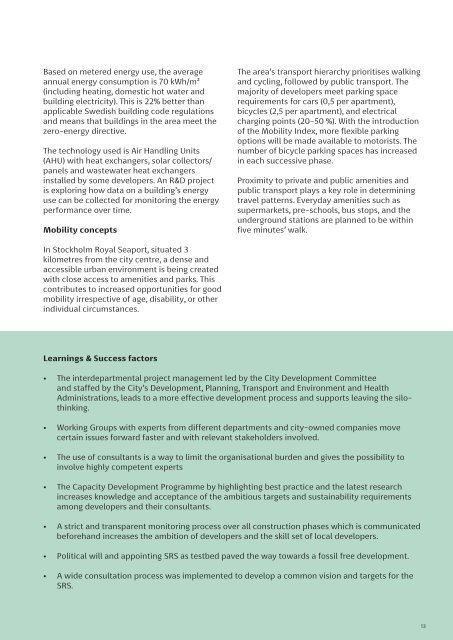Cities4PEDs Atlas_November 2021.pdf
Atlas - From 7 case interviews to recurring strategies and PED relevant aspects
Atlas - From 7 case interviews to recurring strategies and PED relevant aspects
- No tags were found...
You also want an ePaper? Increase the reach of your titles
YUMPU automatically turns print PDFs into web optimized ePapers that Google loves.
Based on metered energy use, the average<br />
annual energy consumption is 70 kWh/m²<br />
(including heating, domestic hot water and<br />
building electricity). This is 22% better than<br />
applicable Swedish building code regulations<br />
and means that buildings in the area meet the<br />
zero-energy directive.<br />
The technology used is Air Handling Units<br />
(AHU) with heat exchangers, solar collectors/<br />
panels and wastewater heat exchangers<br />
installed by some developers. An R&D project<br />
is exploring how data on a building’s energy<br />
use can be collected for monitoring the energy<br />
performance over time.<br />
Mobility concepts<br />
The area’s transport hierarchy prioritises walking<br />
and cycling, followed by public transport. The<br />
majority of developers meet parking space<br />
requirements for cars (0,5 per apartment),<br />
bicycles (2,5 per apartment), and electrical<br />
charging points (20-50 %). With the introduction<br />
of the Mobility Index, more flexible parking<br />
options will be made available to motorists. The<br />
number of bicycle parking spaces has increased<br />
in each successive phase.<br />
Proximity to private and public amenities and<br />
public transport plays a key role in determining<br />
travel patterns. Everyday amenities such as<br />
supermarkets, pre-schools, bus stops, and the<br />
underground stations are planned to be within<br />
five minutes’ walk.<br />
In Stockholm Royal Seaport, situated 3<br />
kilometres from the city centre, a dense and<br />
accessible urban environment is being created<br />
with close access to amenities and parks. This<br />
contributes to increased opportunities for good<br />
mobility irrespective of age, disability, or other<br />
individual circumstances.<br />
Learnings & Success factors<br />
• The interdepartmental project management led by the City Development Committee<br />
and staffed by the City’s Development, Planning, Transport and Environment and Health<br />
Administrations, leads to a more effective development process and supports leaving the silothinking.<br />
• Working Groups with experts from different departments and city-owned companies move<br />
certain issues forward faster and with relevant stakeholders involved.<br />
• The use of consultants is a way to limit the organisational burden and gives the possibility to<br />
involve highly competent experts<br />
• The Capacity Development Programme by highlighting best practice and the latest research<br />
increases knowledge and acceptance of the ambitious targets and sustainability requirements<br />
among developers and their consultants.<br />
• A strict and transparent monitoring process over all construction phases which is communicated<br />
beforehand increases the ambition of developers and the skill set of local developers.<br />
• Political will and appointing SRS as testbed paved the way towards a fossil free development.<br />
Working document<br />
• A wide consultation process was implemented to develop a common vision and targets for the<br />
SRS.<br />
13


















